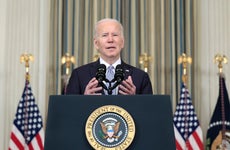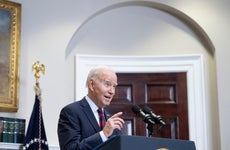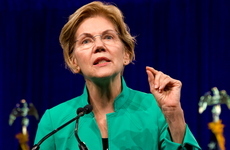Biden administration unveils PSLF changes, payment count adjustment

The Bankrate promise
At Bankrate we strive to help you make smarter financial decisions. While we adhere to strict , this post may contain references to products from our partners. Here's an explanation for .
Today, the U.S. The Department of Education announced permanent changes to Public Service Loan Forgiveness, expanding the program’s eligibility and forgiveness criteria. It also unveiled an executive order set to bring most eligible federal student loans closer to forgiveness through income-driven repayment and PSLF with a one-time payment count adjustment.
The regulation changes and executive action build on the temporary PSLF waiver, which resulted in over 200,000 borrowers getting approved for roughly $14 billion in forgiveness. The waiver expires Oct. 31, 2022.
Executive action to bring most federal loans “closer to forgiveness”
Public Service Loan Forgiveness is a federal program that forgives public servants’ remaining federal student loan balance after making 120 qualifying payments. The program has long been under scrutiny for its stringent eligibility and forgiveness requirements, which require borrowers to jump through administrative hoops and disqualify certain payments, repayment plans and loan types from forgiveness.
Through the Biden administration’s executive order, qualifying borrowers with previously ineligible loans will now receive credit toward forgiveness through PSLF, regardless of payment and loan status. Those who have Direct Loans or Department-managed Federal Family Education Loans will be credited toward forgiveness on an income-driven repayment plan for every month spent in repayment.
Borrowers will also receive credit on eligible payments made before consolidating their federal loans, in a move that will bring many public servants closer to the forgiveness they’ve been promised through the program. Plus, all payments will be PSLF eligible — regardless if they were partial or full — and eligible periods of deferment and forbearance will also be credited toward PSLF.
Borrowers who meet forgiveness criteria thanks to these changes will start receiving discharges of their remaining loan balance in November 2022.
Temporary PSLF waiver still set to expire Oct. 31
Last October, the administration took historic measures aimed at improving PSLF outcomes. They temporarily overhauled the program to broaden eligibility and increase enrollment.
While the executive order mirrors many temporary PSLF waiver benefits, the regulatory changes are distinct from the time-limited waiver changes. The administration has indicated that an extension past the Oct. 31 deadline is likely off the table. Borrowers who wish to take advantage of the waiver’s overhauled regulations still need to apply by the set expiration date to maximize their forgiveness potential in tandem with the regulatory changes.
“Today, we’re encouraging public service workers to take advantage of the program’s temporary changes before the deadline on October 31,” said U.S. Secretary of Education Miguel Cardona in a statement. “At the same time, we’re taking bold steps that will automatically move more hardworking public service workers closer to forgiveness and making permanent changes to reduce the red tape that riddled the PSLF program.”
Permanent PSLF changes set for 2023
For the past few months, PSLF has been undergoing a process — called Negotiated Rulemaking — in which a group of elected negotiators hold a comment period and publicly discuss regulatory changes to pre-existing federal relief programs.
With negotiations complete, the PSLF regulation changes will take effect in July 2023. Here’s a breakdown of the regulatory amendments and how borrowers can stand to benefit.
Automatic credit toward forgiveness
Due to payment counting inaccuracies under the current regulations, some borrowers who’ve reached payment count thresholds under IDR plans or PSLF have historically been unable to access forgiveness.
Starting in November, the Department will begin adjusting payment counts to include:
- Any month in repayment regardless of plan, loan type and payment status.
- Any month of eligible repayment as well as periods of forbearance and deferment prior to consolidation.
- Any month spent in deferment, excluding in-school deferment, prior to 2013.
- Months spent during at least 12 consecutive months of forbearance.
- Months spent during at least 36 cumulative months in forbearance.
What this means for you
If you qualify for PSLF or IDR, you’ll receive adjusted forgiveness credit under the new regulatory guidelines. Beginning November 2022, if you’ve made 20 to 25 years of eligible payments, you’ll receive loan discharges through IDR. Plus, if you apply for PSLF before the October deadline and reach 120 payments due to the adjusted payment regulations, you’ll also have your remaining balances canceled.
Starting July 2023, the Department will automatically apply these regulations to all Direct Loans and Department-managed FFEL Loans for those who wouldn’t otherwise reach the program’s eligibility requirements.
Alleviated payment requirements
Under the current regulations, in order to count a payment toward forgiveness, it must be made on time, in full and through an IDR plan. Outside of the federal payment pause (set to expire on Jan. 1), forbearance or deferment periods are also not eligible for forgiveness towards PSLF.
On top of the retroactive credit awarding, the ED will alleviate these requirements within its 2023 regulatory package to make forgiveness easier to obtain.
What this means for you
Late, partial and lump-sum payments will now be counted as forgiveness credit under PSLF as long as you’re working for an eligible employer. Plus, specific months in periods of deferment or forbearance will also count.
For example, if you’re serving in the military or in a period of deferment due to economic hardship, you’ll still be awarded credit should you work for a qualifying employer.
Related Articles

New Biden student debt plan could forgive up to $20,000 in interest for millions

Biden administration forgives $1.2 billion in student loans through SAVE Plan

Biden launches “Most affordable student loan plan ever” weeks before payment pause ends

Congressional Democrats push for $50,000 in federal student loan forgiveness